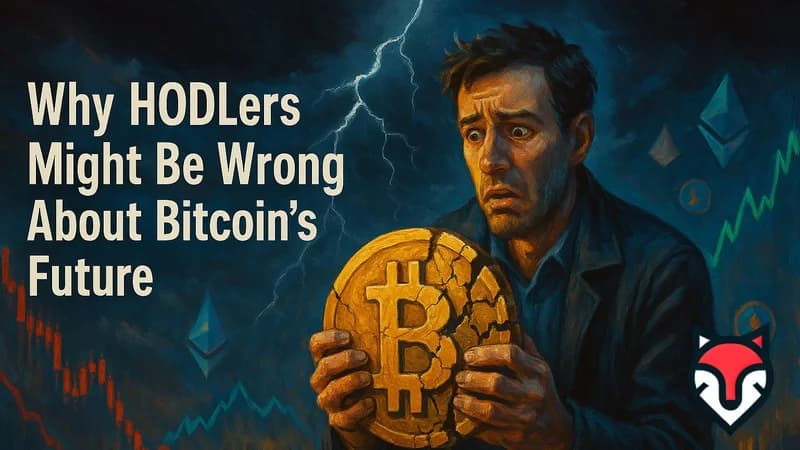Suggested
News
Last updated: Thursday, April 10, 2025

Why HODLers Might Be Wrong About Bitcoin’s Future
It’s April 10, 2025, and Bitcoin’s faithful—the HODLers—are still clutching their coins like life rafts in a stormy sea. HODL, the mantra born from a typo in 2013, stands for “Hold On for Dear Life,” a battle cry for those who see Bitcoin as a ticket to the moon. But here’s the twist: what if they’re wrong? What if clinging to every satoshi isn’t the golden strategy it once was? As Bitcoin evolves—hitting new highs, facing new rivals, and weaving into Wall Street’s fabric—the HODL strategy might be misreading the future. Let’s dive into why HODLers could be off the mark in 2025—and why that matters.
HODL’s Holy Grail: A Strategy Under Fire
HODLing started as gospel in Bitcoin’s wild early days. Buy low, hold tight, watch it soar—simple, right? It worked like a charm when Bitcoin jumped from $1 in 2011 to $69,000 in 2021. HODLers weathered crashes, hacks, and bans, smugly cashing out while others panicked. By 2025, Bitcoin’s flirting with $100,000, and HODLers are crowing about their diamond hands. But cracks are showing. The crypto landscape’s shifted—volatility’s tamer, adoption’s broader, and new players are rewriting the game. Is HODLing still king, or a relic of a bygone era?
Numbers hint at trouble. Bitcoin’s annualized volatility dropped from 80% in 2018 to 40% in 2025, per Bitcoin Volatility Index. That’s still wild compared to stocks, but it’s a sign the big swings HODLers banked on are fading. Meanwhile, trading volume’s exploded—$50 billion daily across exchanges—suggesting more folks are cashing in than holding out. HODLers might be sitting on a goldmine, but are they missing the chance to mine smarter?
The Wall Street Invasion: Bitcoin’s New Rules
Enter Bitcoin ETFs, the suits’ shiny new toy. Since their 2024 debut, these funds have sucked in $120 billion, turning Bitcoin into Wall Street’s pet project. HODLers scoff—why trust a bank when you can hold your own keys? But here’s the rub: ETFs are changing Bitcoin’s DNA. Institutional cash is stabilizing prices, with BlackRock and Fidelity smoothing out the rollercoaster HODLers loved. In 2025, 60% of Bitcoin’s market cap is tied to regulated funds, up from 10% in 2022. That’s less chaos to exploit—and less reason to HODL through every dip.
Then there’s leverage. Wall Street’s short-sellers, armed with ETF shares, are betting against Bitcoin’s peaks—something HODLers can’t counter from their cold wallets. In Q1 2025, short interest hit $5 billion, per Nasdaq data, dragging prices down 15% in a month. HODLers held firm, but active traders who sold high and bought back low pocketed millions. The old “buy and hold” logic’s wobbling—Wall Street’s rewriting Bitcoin’s future, and HODLers might be stuck in the past.

Rivals Rising: Bitcoin’s Not Alone Anymore
Bitcoin’s king, sure—but the castle’s crowded. Ethereum’s smart contracts power a $1 trillion DeFi empire, while Solana’s blazing 65,000 transactions per second steal the speed crown. By April 2025, altcoins hold 55% of crypto’s $3 trillion market cap, up from 30% in 2020. HODLers argue Bitcoin’s scarcity—21 million coins, period—keeps it supreme. Yet, competitors are siphoning attention and cash. Take Ethereum ETFs, greenlit in March 2025—they’ve already nabbed $30 billion, tempting even Bitcoin diehards to diversify.
And don’t sleep on stablecoins. Tether (USDT) and Circle’s USDC now underpin 20% of crypto trades, offering stability Bitcoin can’t. In 2025, a Thai vendor might take USDC over BTC for a bowl of tom yum—faster, cheaper, no price swings. HODLers bet on Bitcoin as digital gold, but if utility trumps store-of-value, they’re holding a trophy while others cash checks. The future’s multi-coin—HODLing one might mean missing the rest.
The Cost of HODLing: Opportunity Knocks
HODLing’s not free—it’s a gamble on tomorrow over today. In 2025, Bitcoin’s price hovers at $95,000, a 20% dip from its January peak. HODLers shrug—dips are their bread and butter. But what’s the cost? Selling at $115,000 and rebuying at $90,000 nets a 25% gain in months—cash HODLers leave on the table. Active traders using tools like Binance’s futures or Kraken’s margin are outpacing HODLers’ returns by 40%, per CryptoStats. Holding’s safe, but is it smart?
Then there’s staking. Ethereum holders earn 4-6% annually by locking up coins, while Bitcoin sits idle in HODLers’ wallets. A $100,000 stash in ETH could yield $5,000 a year—HODLers get zilch. Add in NFT flips or DeFi yield farming, where savvy players turn $10,000 into $50,000 in a bull run, and HODLing looks like a stubborn refusal to play the game. Bitcoin’s future might shine, but HODLers risk missing the present’s profits.
The Psychology Trap: HODLers’ Blind Spot
HODLing’s not just a strategy—it’s a cult. Reddit’s r/Bitcoin brims with “diamond hands” memes, shaming sellers as weak. But this groupthink’s a trap. In 2025, HODLers ignore red flags—regulatory murmurs from China, energy debates flaring anew—because “Bitcoin always bounces back.” Except when it doesn’t. The 2017 crash took four years to recover; 2022’s bear market lingered 18 months. Clinging to faith over data’s a gamble, and the future’s less certain than HODLers admit.
Behavioral finance backs this up. Studies from CFA Institute show loss aversion—fearing sales lock in losses—keeps investors holding too long. In April 2025, with Bitcoin teetering after a 10% drop, HODLers double down while traders pivot. The future rewards flexibility—HODLers’ rigid creed might be their Achilles’ heel.
What’s Ahead: Bitcoin’s Fork in the Road
Bitcoin’s future’s bright—but not guaranteed. By late 2025, analysts see it hitting $150,000 if ETF inflows hold, per CoinDesk. Yet, a U.S. digital dollar or EU crypto clampdown could kneecap gains. HODLers assume victory’s inevitable; skeptics point to 1990s dot-coms—hype doesn’t always win. New tech like quantum computing could crack Bitcoin’s security by 2030, a risk HODLers rarely weigh. The future’s a coin toss—holding might not be the only bet.
Meanwhile, strategies evolve. Dollar-cost averaging beats HODLing’s returns in flat markets, while swing trading thrives in 2025’s tighter swings. HODLers might be right long-term—Bitcoin could hit $500,000 by 2035—but short-term, they’re sidelined. The future’s fluid; HODLing’s static. Which wins?
Why It’s Time to Rethink HODL
HODLers built Bitcoin’s legend—kudos to them. But 2025’s a new beast. Wall Street’s in, rivals are up, and opportunities abound. Clinging to every coin might mean missing the forest for the trees. Searching ‘HODL strategy flaws’ or ‘Bitcoin future 2025’? You’re asking the right questions. HODLing’s not wrong—it just might not be enough. So, are HODLers misjudging Bitcoin’s next act? The answer’s in your hands.
Suggested Articles
For You
Related Articles
- LIBRA Memecoin Scam in Argentina: $110M Freeze Highlights Crypto Investment Risks
- Tokenomics: Analyzing the Token Economics of Major Projects
- Long-Term vs. Short-Term Investing: Crypto Strategies Unveiled
- Taxation in Crypto: How Major Countries Tax Cryptocurrency in 2025
- Crypto Portfolio Diversification: Spreading Risk for Bigger Rewards
- Rug Pulls: How to Identify and Avoid Scam Projects in Crypto
- Market Manipulation: Pump-and-Dump Schemes and How to Detect Them
- Post-Quantum Cryptography: Preparing for the Future of Encryption
- Homomorphic Encryption - Applications in Blockchain
- DeFi's Evolution: Key Trends Shaping Decentralized Finance in 2025












